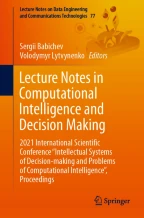Abstract
The article describes problems that cannot always be solved by machine learning algorithms to get an accurate result. For such tasks, you need to use ensembles that actually combine several algorithms in order to simultaneously learn and correct errors, thereby improving the accuracy of results at times, compared to other algorithms. Here are described high accuracy and stability of ensembles, since they are extremely important for fast processing of a large amount of data and at the same time a fairly accurate result. Today, ensembles actively compete with neural networks, since both are quite effective for the same tasks. The work is devoted to the study of ensembles, and more specifically Adaptive Boosting. The main ensemble methods and their advantages and disadvantages were considered. Here are examined the basic principles of the AdaBoost boosting ensemble, analyzes the industries where this ensemble is already used. The study discusses ways for ensembles to work: stacking, running, and boosting. This work analyzes the boosting algorithms such as AdaBoost and gradient boosting. The advantages and disadvantages of these algorithms are presented. This work presents the principle of operation of the AdaBoost algorithm and provides an example of its operation. An analytical review of the AdaBoost algorithm is also given. Examples of using AdaBoost are given. The AdaBoost algorithm was experimentally applied to the data set and its effectiveness was tested. The effectiveness of ensemble boosting methods that compete with neural networks is analyzed. As a result, it is proved that they are somewhat more stable and understandable, which is why they get an advantage in the choice. Also, the AdaBoost algorithm can slightly improve the result compared to “strong” classifiers. Here are presented prospects for applying the AdaBoost algorithm, which is still being developed and will be used in further research.
Access this chapter
Tax calculation will be finalised at checkout
Purchases are for personal use only
Similar content being viewed by others
References
Merjildo, D.A.F., Ling, L.L.: Enhancing the performance of adaboost algorithms by introducing a frequency counting factor for weight distribution updating. In: Alvarez, L., Mejail, M., Gomez, L., Jacobo, J. (eds.) CIARP 2012. LNCS, vol. 7441, pp. 527–534. Springer, Heidelberg (2012). https://doi.org/10.1007/978-3-642-33275-3_65
Boyko, N., Boksho, K.: Application of the naive bayesian classifier in work on sentimental analysis of medical data. In: The 3rd International Conference on Informatics & Data-Driven Medicine (IDDM 2020), Växjä, Sweden, November 19–21, pp. 230–239 (2020)
Boyko, N., Mandych, B.: Technologies of object recognition in space for visually impaired people. In: The 3rd International Conference on Informatics & Data-Driven Medicine (IDDM 2020), Växjä, Sweden, November 19–21, pp. 338–347 (2020)
Boyko, N., Tkachuk, N.: Processing of medical different types of data using hadoop and Java mapreduce. In: The 3rd International Conference on Informatics & Data-Driven Medicine (IDDM 2020), Växjä, Sweden, 19–21 November, pp. 405–414 (2020)
Breiman, L.: Prediction games and arcing algorithms. Neural Comput. 11(7), 1493–1517 (1999)
Brownlee, J.: Boosting and adaboost for machine learning (2016). https://machinelearningmastery.com/boosting-and-adaboost-for-machine-learning/
Buhlmann, P., Yu, B.: Boosting with the L2 loss: regression and classification. J. Am. Stat. Assoc. 98(462), 324–339 (2003)
Friedman, J.: Another approach to polychotomous classification. Mach. Learn. (2004)
Friedman, J., Hastie, T., Tibshirani, R.: Additive logistic regression: a statistical view of boosting. Ann. Stat. 28, 337–407 (2000)
Friedman, J.: Greedy function approximation: a gradient boosting machine. Anna. Stat. 29(5) (2001)
Kumar, A.: The ultimate guide to adaboost algorithm. What is adaboost algorithm? (2020). https://www.mygreatlearning.com/blog/adaboost-algorithm/
Kyrychenko, Y.: Features of development a system of number plate localization based on the viola-jones method using adaboost. Paradig. Knowl. 2(28) (2018)
Lee, Y., Lin, Y., Wahba, G.: Multicategory support vector machines, theory, and application to the classification of microarray data and satellite radiance data. J. Am. Stat. Assoc. 99, 67–81 (2004)
Jordan, M.I., Mitchell, T.M.: Machine learning: trends, perspectives, and prospects. Artif. Intell. 349(5), 255–260 (2015)
Murygin, K.V.: Features of the implementation of the adaboost algorithm for detecting objects in images. Shtuchniy Telecom (3), 573–581 (2009)
Zhang, P., Zhang, G., Pan, Q.: An ensemble learning method for classification of multiple-label data. J. Comput. Inf. Syst. 11(2) (2015)
Zhu, J., Zou, H., Hastie, T.: Multi-class adaboost. Stat. Interface 2(3), 349–360 (2003)
Author information
Authors and Affiliations
Corresponding author
Editor information
Editors and Affiliations
Rights and permissions
Copyright information
© 2022 The Author(s), under exclusive license to Springer Nature Switzerland AG
About this paper
Cite this paper
Boyko, N., Kmetyk-Podubinska, K., Andrusiak, I. (2022). Application of Ensemble Methods of Strengthening in Search of Legal Information. In: Babichev, S., Lytvynenko, V. (eds) Lecture Notes in Computational Intelligence and Decision Making. ISDMCI 2021. Lecture Notes on Data Engineering and Communications Technologies, vol 77. Springer, Cham. https://doi.org/10.1007/978-3-030-82014-5_13
Download citation
DOI: https://doi.org/10.1007/978-3-030-82014-5_13
Published:
Publisher Name: Springer, Cham
Print ISBN: 978-3-030-82013-8
Online ISBN: 978-3-030-82014-5
eBook Packages: Intelligent Technologies and RoboticsIntelligent Technologies and Robotics (R0)
